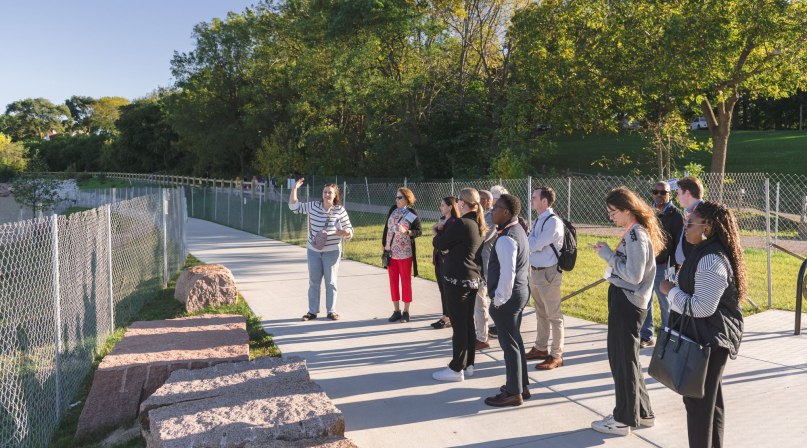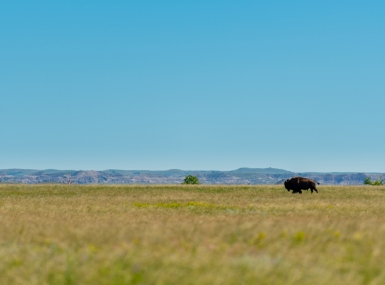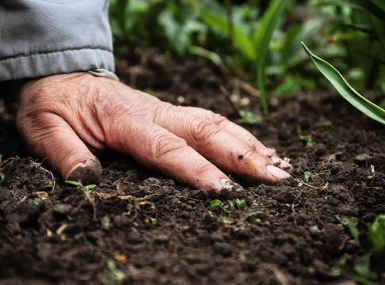Milwaukee County showcases beach renovation

Key Takeaways
For years, the beach at Milwaukee County, Wisconsin’s South Shore Park was widely considered one of the worst in the country and its poor water quality led to repeated closures. After analysis found that the water was too polluted to successfully restore the beach into a healthy swimming area, the county converted it into greenspace and transformed the rocky shoreline at the other end of the park into a sandy swimming area.
County officials on Oct. 8 took a tour of the beach rehabilitation project, which officially reopened to the public in August, during NACo’s Large Urban County Caucus (LUCC) conference.
The previous beach at South Shore Park was rife with E. coli, which the University of Milwaukee School of Freshwater Sciences helped determine was likely due to localized runoff from the park and parking lot areas, excrement from gulls and waterfowl, breakwater that limits water circulation with the lake and regional stormwater runoff and combined sewer overflows.
The U.S. Environmental Protection Agency, Great Lakes National Program Office, Wisconsin Department of Natural Resources and local advocates, particularly the South Shore Park Friends group “whose dedication and volunteerism kept this effort alive” all helped make the beach transformation possible, according to Milwaukee County Executive David Crowley. South Shore stands as a national model for what can happen when local, state and federal partners come together, he noted.
The partnerships “helped us to improve the water quality and continue to connect the community to cleaner, healthier recreation,” Crowley said. “And so, this really represents our shared value, [of] stewardship, sustainability and equitable access — values that NACo members across the country are advancing in their own communities.
“We believe that this particular project represents an important investment that is a result of years of collaboration, making our public space not only safer, but just more welcoming for everybody.”
To deter people from continuing to swim in the old beach location, the parks system planted a vegetative barrier along the edge and installed a revetment shoreline structure to make sure the park was protected from waves, according to Stacy Hron, a Lake Michigan program coordinator at Wisconsin Department of Natural Resources.
“We had a really bad storm here in January of 2020, which wreaked havoc on much of the infrastructure on this lakeshore,” Hron said. “So, that was a really good learning point for everybody and for all the projects I work on across the lakeshore, to make sure we are really thinking about the resiliency of all of these structures to the changes that we are experiencing in weather.”
South Shore Park now has a water filtration basin that intercepts water coming off the trail before it gets to the beach, filtering out contaminants. The type of sand used at the beach was also intentional, Hron noted.
“The sand of the beach, if you touch it, it’s not sandcastle sand, it’s coarser sand,” Hron said. “It doesn’t hold the water, it doesn’t allow the bacteria to have a nice home, so it’s nice because it does give us a nice sand beach, but it does not create the same water quality issues.”
The county also solicited public input to ensure that South Shore Park was somewhere that people wanted to be and were excited about, said Natalie Dutack, a Milwaukee County Parks program supervisor.
“It’s very unique to move a beach, and it’s also very unique that we were able to incorporate some amenities based on that community input that we got,” which included building a wider trail to address congestion issues between pedestrians and cyclists, installing a foot washing system, expanding the recreation area and making the beach ADA-accessible,” Dutack said.
Roughly 60% of the park system’s operating budget is funded through revenue, a significant amount of which comes from the county’s beer gardens (including the beer garden at South Shore Park), according to Guy Smith, Milwaukee County Parks executive director.
“Beer gardens are a great way to help bring in revenue to actually pay for our parks,” Crowley said. “Being able to invest, particularly in green spaces that help to bring both physical and mental refuge to folks, it’s needed.
“So, we’re glad to be here, because our parks boost our economy, support the health and well-being for all of our community and provide those avenues for families, for older adults and our children to be able to enjoy our outdoor spaces.”
Related News

House Natural Resources Committee advances the Endangered Species Act Amendments Act of 2025
On December 17, the House Natural Resources Committee advanced the Endangered Species Act (ESA) Amendments Act of 2025 (H.R. 1897). The version passed by the committee adopted several changes from the initial bill and would address key county concerns by improving the implementation of the ESA. The legislation now awaits a floor vote before the whole U.S. House of Representatives.

Senators introduce bipartisan UPGRADE Act to support small and rural public water systems
On December 15, Sens. Lisa Blunt Rochester (D-Del.) and Roger Wicker (R-Miss.) introduced the Unincorporated Partnerships for Grant Resources, Assistance, and Drinking Water Enhancements (UPGRADE) Act (S. 3465), a bipartisan bill that would strengthen federal support for small public water systems and helps unincorporated communities access clean and affordable water.

U.S. Department of Agriculture unveils $700 million for regenerative agriculture
On December 10, U.S. Secretary of Agriculture Brooke Rollins announced the launch of a $700 million pilot program to support regenerative agriculture practices across the country.
County News
Leon County Parks hits triple crown with cross country course

